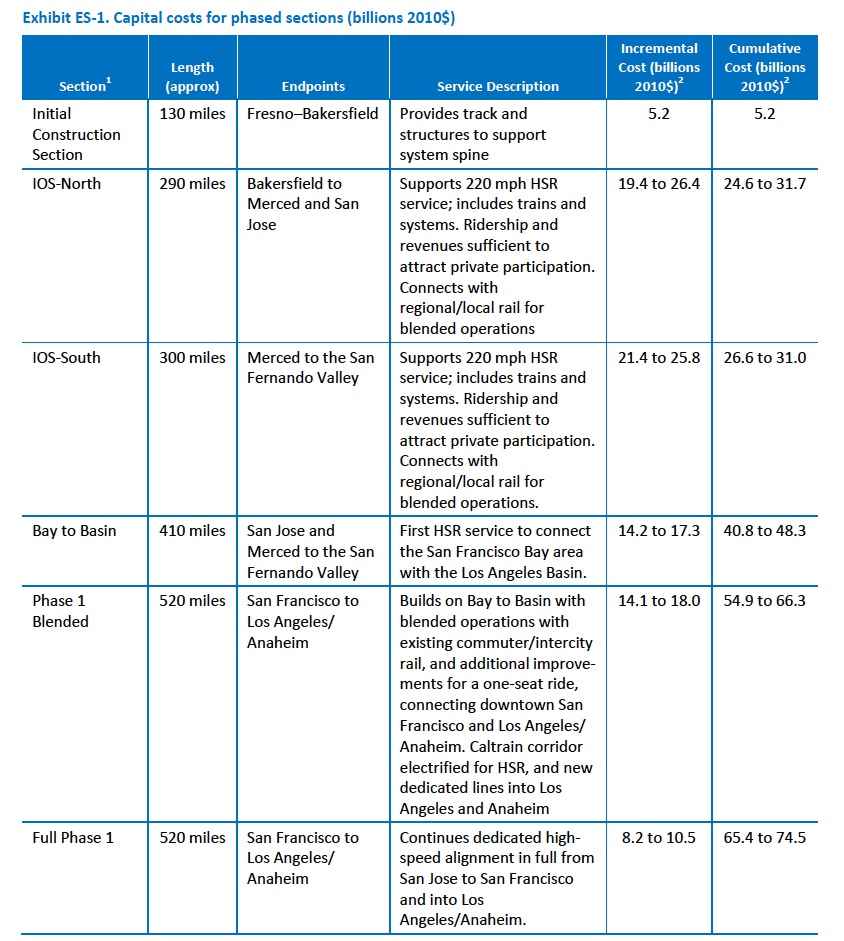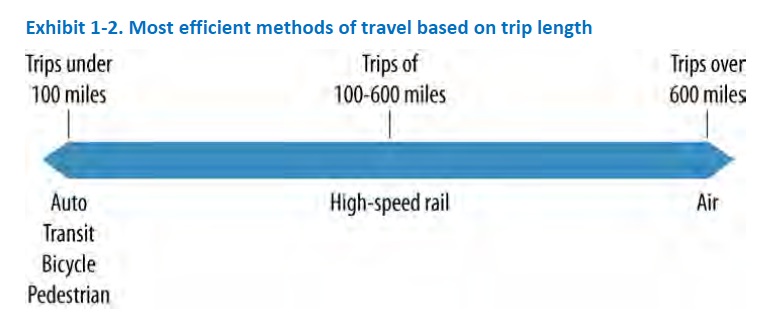CALIFORNIA HIGH-SPEED RAIL AUTHORITY
Executive Summary
In 2008, Californians voted to develop a statewide high-speed rail (HSR) program. The 2012 Business Plan marks the transition from the vision of a world-class high-speed rail system to the realities of building and operating that system. Reflecting that change, this Business Plan differs significantly from previous versions. Advances in engineering and design have provided far better information about the detailed scope and costs of the program. The environmental documentation, review, and clearance process has progressed. Ridership assumptions and modeling were thoroughly re-evaluated and tested with an independent panel of experts to support revenue projections. Risks have been identified and mitigation plans put into place. Cost-effective and timely methods to achieve the goals of the High- Speed Rail Bond Measure, Proposition 1A, have been developed in cooperation with regional and local transportation partners. Business models for delivering the program and the role of the private sector have been defined based on international experience and extensive discussions with rail operators. The role of the private sector has been clarified, also based on the best experience of HSR operations and outreach to potential investors. Realistic and conservative costs, contingencies, schedules, and funding options have been prepared and used to develop a plan for moving forward.
The case for investing in high-speed rail in California is tied to two key factors:
- Recognition that continued growth will require major investments, measured in the tens of billions of dollars, in expanded transportation systems over the coming decades; and,
- High-speed rail can meet those demands more effectively and at lower costs than the alternatives, and can be delivered through a fiscally responsible phased implementation plan that ties the system together with regional and local rail networks and generates net positive cash flow from its operations.
The need is clear. Today, our transportation systems are straining to meet current demand. Congestion on our roads results in $18.7 billion annually in lost time and wasted fuel. Air flights between the Los Angeles and San Francisco metropolitan areas—the busiest short-haul market in the U.S.—are the most delayed in the country, with approximately one of every four flights late by close to an hour or more.
Continued population and economic growth will place even more demand on mobility systems that are already overburdened. Over the next 30 to 40 years, California is projected to add the equivalent of the current population of the state of New York. There is no question: meeting the demands of that growth will require major investments in transportation infrastructure over the next generation. Those investments will measure in the tens of billions of dollars. The question will not be if those investments need to be made, but how the investments that will be made can provide the greatest benefit.
As has been proven around the world, high-speed rail, integrated into a balanced transportation system, can meet a large part of the increased demand in a sustainable, cost-effective manner. Providing equivalent new capacity through investment in highways and aviation would cost California almost twice as much as the Phase 1 high-speed rail system and would require approximately:
- 2,300 miles of new highways
- 115 new airport gates
- 4 new airport runways
The costs of these expansions would exceed $170 billion over the next 20 years. Such highway expansions would be contrary to important state policies such as AB 32, the Global Warming Solutions Act of 2006, and SB 375, the Sustainable Communities and Climate Protection Act of 2008. Those new highways would also impose millions of dollars in annual maintenance costs that are not factored into the cost comparison, while operations and maintenance costs for high-speed rail are covered by revenues. As has been the case in San Francisco and Los Angeles, the addition of new runways not only would be costly, but may not be possible in light of community and environmental concerns.
As detailed in this Plan, a statewide HSR system can be delivered to the citizens of California, producing economic benefits, enhancing and supporting environmental and energy goals, creating near and long-term employment, enhancing mobility, and saving money. This Business Plan lays out the framework for doing so in a way that recognizes the budgetary and economic realities facing the state and country today.
Building the entire system will take longer and cost more than previously estimated; however, as detailed in this Business Plan, the previous notion of what the system will look like and how it will be built has also been updated. Answers to the questions regarding how much longer it will take and how much more it will cost will depend in part on the pace and type of funding that is provided. It also will depend on
decisions on system routing and design to be made by a wide range of stakeholders, including communities, elected officials, the federal government, and partner transportation agencies.
Economic analysis shows that the benefits of the system far outweigh the costs of building, operating, and maintaining it, even with higher costs factored into the equation. Californians will begin to see these benefits next year, when initial construction will provide a much-needed boost to the Central Valley, the fastest growing part of the state and the region hardest hit by unemployment. Almost 100,000 jobs will be generated by the first construction work.

Download full report (PDF): California High-Speed Rail Program Draft 2012 Business Plan
About the California High-Speed Rail Authority
www.cahighspeedrail.ca.gov
“Established in 1996, the California High-Speed Rail Authority (Authority) is the state entity responsible for planning, constructing and operating an 800-mile-long high-speed train system serving California’s major metropolitan areas. The Authority has a nine-member policy board (five appointed by the governor, two appointed by the Senate Rules Committee, and two by the speaker of the Assembly) and a core staff. The majority of the environmental, planning and engineering work is performed by private firms under contract with the Authority.”
Tags: California, California High-Speed Rail Authority, High Speed Rail






 RSS Feed
RSS Feed